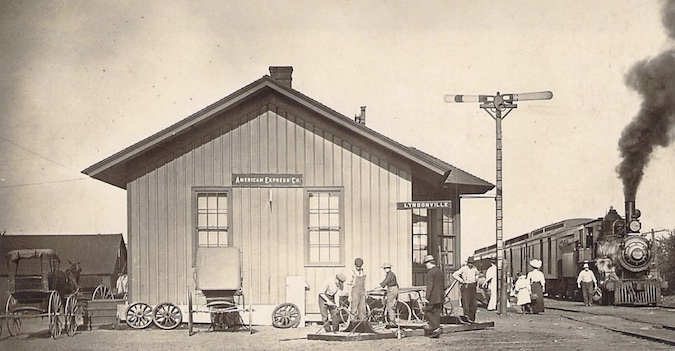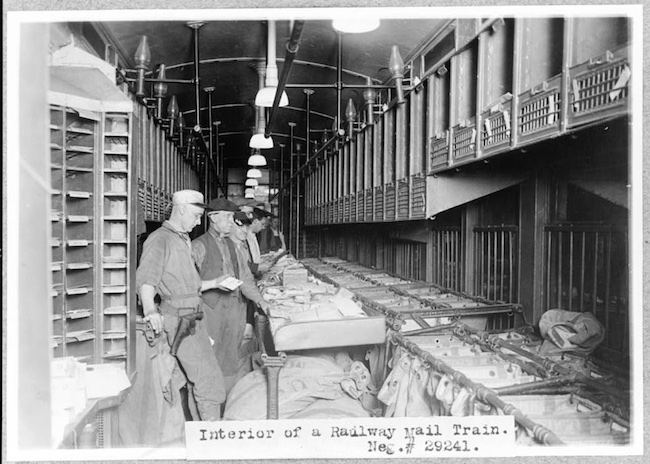Railroads played a key role in delivering mail with perfection demanded of clerks
By Catherine Cooper, Orleans County Historian
Illuminating Orleans – Vol. 3 No. 8
The Medina Historical Society will celebrate the variety and power of letters at its second annual “Letters Alive” program which will be held at 7 p.m. on Monday, Feb. 27, at Lee-Whedon Memorial Library in Medina.
The Society’s first Letters Alive program generated a very positive response to the emotional power of the letters shared. Perhaps we are developing a greater appreciation of letters as the practice of letter-writing declines.
But how did those letters get from Point A to Point B? While researching the history of Lynhaven Cemetery this past summer, we discovered an interesting local link to one aspect of postal history.
Since its inception in 1775, the Postal Service has taken advantage of available forms of technology and transportation to expedite the efficient delivery of mail. Stagecoaches, steamboats, the Pony Express, dog sleds, airplanes and even balloons have played a part in the delivery of correspondence. The role of the railroad tends to be overlooked. However, the Railway Mail Service (RMS) played a central role in mail delivery to all areas of the country for over 100 years, ending as recently as 1977.
Responding to complaints about the inadequacy of stagecoach and steamboat mail delivery, President Martin Van Buren signed an act designating railroad routes as postal routes in 1838. In 1869, the RMS was officially designated to handle the sorting and designation of mail on trains. Working in specially designed carriages, Railway Post Office clerks sorted the mail for dispatch and delivery as they travelled.

The Lyndonville Train Station as it appeared in the 1900s. (Courtesy of the Town of Yates)
Millard Fillmore Toms, a Lyndonville resident, worked as a Railroad Post Office clerk. Born in 1856, he was the son of Harmon Toms and Catherine (Allen). A cooper by trade, Harmon Toms had moved to the Lyndonville area from the Mohawk Valley. The family lived on Maple Avenue in Lyndonville.
Millard learned coopering skills and later worked as a grocery store clerk. He married Matilda Jean (Jennie) Mael in 1880.
Thanks to the influence of State Assemblyman, Hon. H.M. Hard, who resided in Lyndonville, Millard secured a job as a mail clerk on the Ontario Division of the New York Central Railroad line in 1881.
Since trains ran on an exact schedule, employees were required to own a specific watch, which cost $50. Millard and his family borrowed, scrimped, and saved to purchase this watch.
At first, Millard worked locally, travelling from Rochester to Niagara Falls and back in one day. Though well-paid, the job was demanding and exacting. Railroad mail staff handled all postal processing functions: they sorted first-class, magazines and newspapers for dispatch to post offices along the route.
Clerks had to master a complex distribution network of routes, junctions, timetables, and local delivery details. They were periodically tested on their knowledge, accuracy, and speed. A score of 96% would warrant a warning.
The New York Central Railroad extended to Oswego in 1895, which meant longer hours for Millard, as the round trip to Niagara Falls took almost twenty-four hours.
In 1881, Millard and his wife purchased an old house outside of the village and had it moved to Maple Avenue. They also bought and operated a fruit farm on East Lake Shore Road. A daughter, Olive May, born in 1884, died in 1887 of typhoid fever. A second daughter, Imo, was born in 1888.
On November 7, 1905, Millard, then aged 49, was working aboard a train which was involved in a head-on collision with another train in Liverpool, NY. He died within a few hours and is buried at Lynhaven Cemetery. He had worked in the rail service for twenty-four years and eleven months. Millard took pride in his position and his work. His last words were “Look after my mail.”
(Source: A History of the Town of Yates in Orleans County / Gardepe & Register)








































































